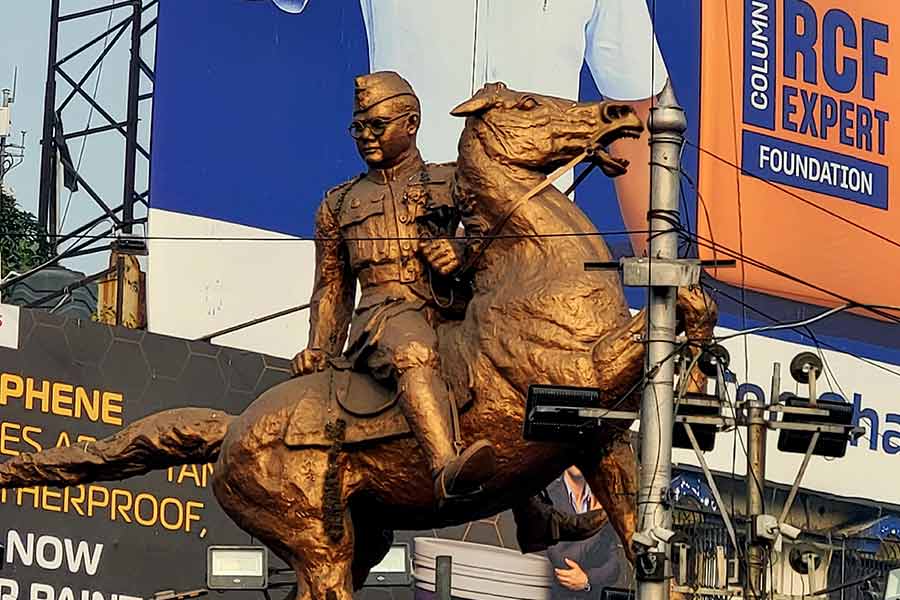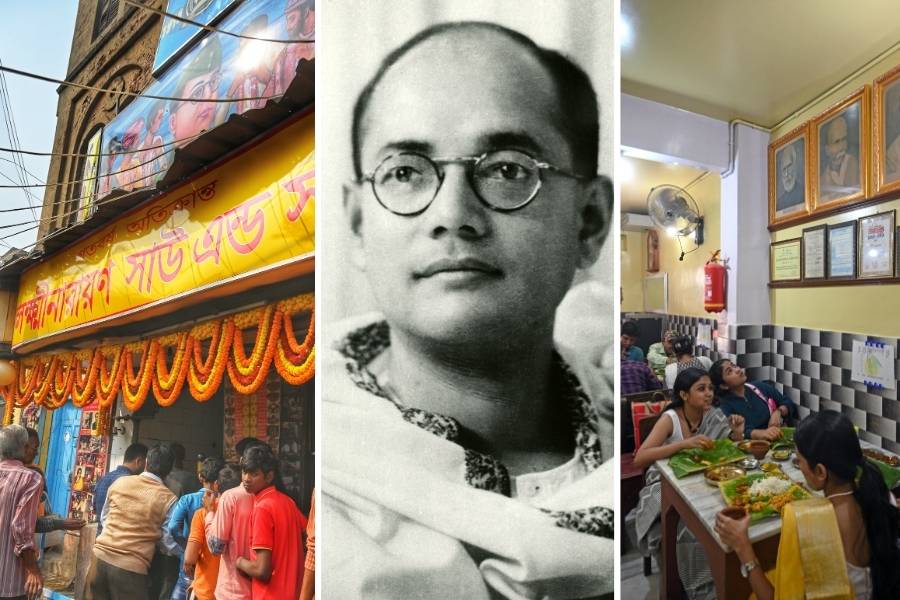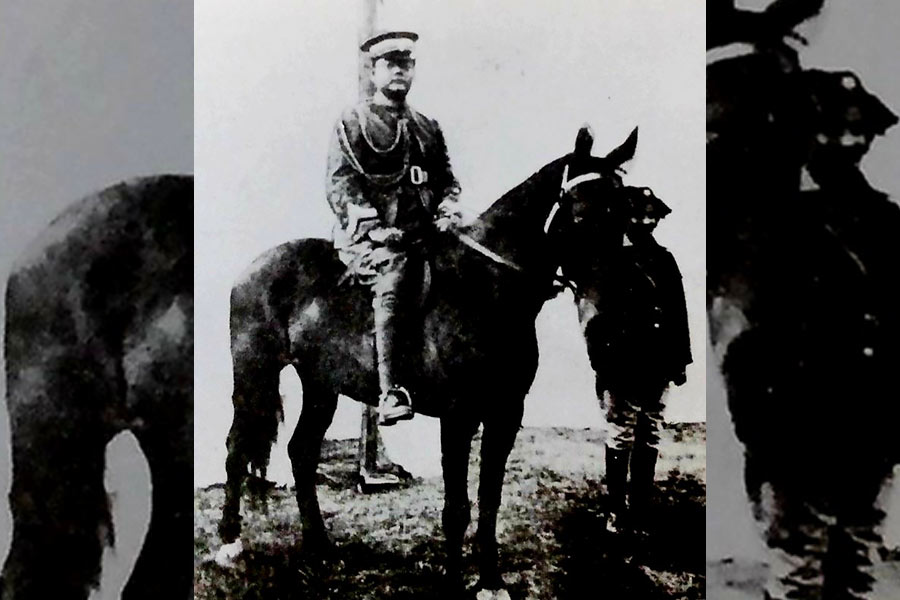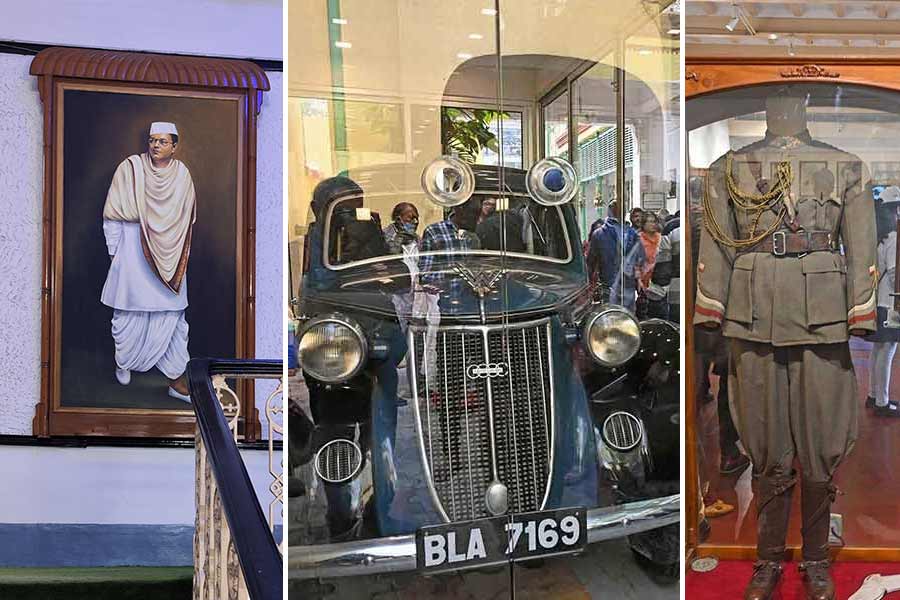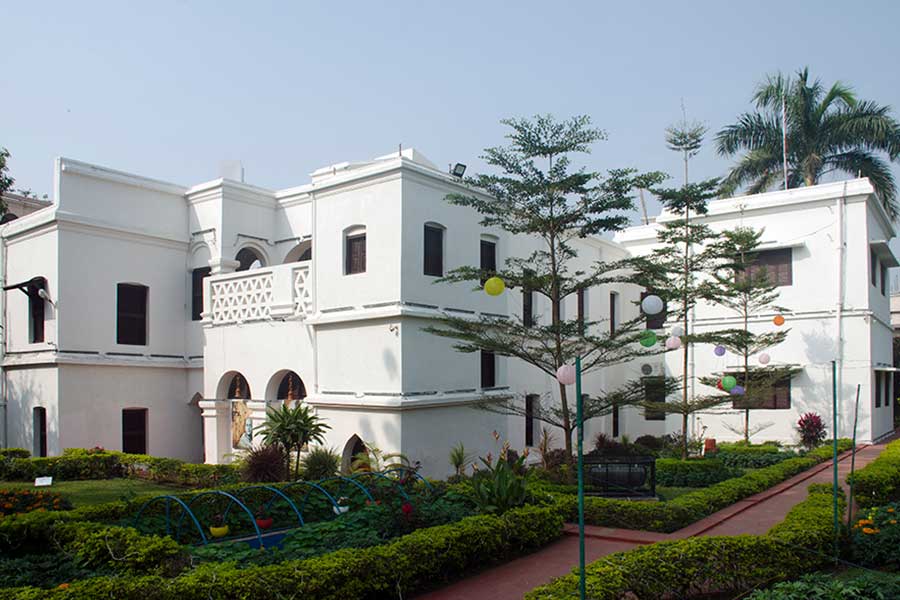Does a statue ever become an identity of a vibrant city?
The answer is yes.
The way the Statue of Liberty in New York or The Motherland Calls, the tallest statue of Europe, represents the Russian city of Volgograd (formerly Stalingrad) or the Merlion in Singapore creates an unforgettable identity for each of these three great cities, there can be no doubt that a statue is, perhaps, the best object to recall a city.
Calcutta for long has a legacy of heritage. Till the late-1960s, Calcutta had several historical edifices like well-designed buildings, a century-old market complex, an impressive dome of General Post Office and an iconic hanging steel bridge to represent its identity in cinemas, theatres, picture postcards and songs.
How Netaji’s popularity grew
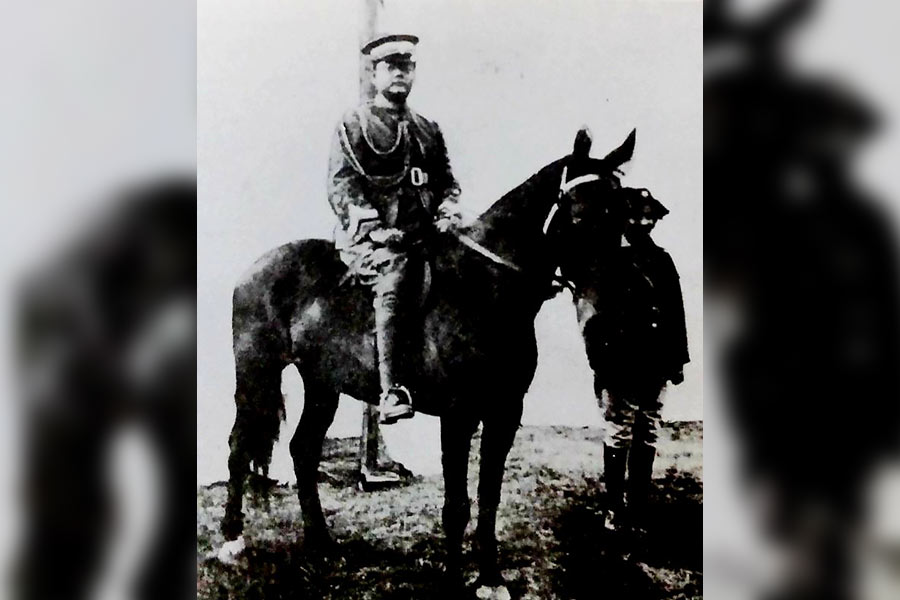
Bose rides a horse in military uniform at the Park Circus Maidan for the Calcutta Congress session in 1928
Subhas Chandra Bose, before becoming ‘Netaji’ in Germany and Japan since 1943, was Bengal’s tallest leader, who showed his mettle by challenging Mahatma Gandhi’s style of working in the Congress. His thrilling ‘Great Escape’ from Calcutta to Kabul and then to Berlin via Moscow against a fake passport to form an army in Germany was a tale of legend.
His three-month-long risky expedition in a submarine to arrive in Tokyo and then to Singapore to take over Azad Hind Fauj and then wage a direct war against the Allied Forces cemented his position in the annals of Indian history as a modern-day warrior leader who took part in the Second World War.
By mid-1945, rumours of his death or mysterious disappearance were rife, and Netaji became taller a figure than Gandhi and Nehru in India. Such was his legend that people in Bombay started worshipping Ganesh idols in the form of Netaji. Across north India, Netaji’s portraits and pictures flooded posters, matchboxes, cine documentary, advertisement among other things for the next several decades.
In Bengal — his home state which was by then ravaged by war, famine, riots and a horrific Partition — Netaji became a part of folklore and the only hero who caught the imagination of common Bengalis.
In the hearts of common Indians, his image had been reshaped as that of a warrior issuing the call for liberty from horseback in a military uniform. By the end of 1940s, Bose, in the eyes of his countrymen, was more of a military man than a modern-day Congress leader.
Post-Independence celebrations on January 23
On August 15, 1947, the famous Clive Row of Calcutta’s Dalhousie Square was renamed as Netaji Subhas Road. Almost overnight, many schools, colleges, refugee colonies, local clubs and cultural organisations were named after Netaji. His birthday on January 23 every year became a day of grand celebrations in every corner of Bengal and India. In 1950s Calcutta, it resembled an enthusiastic street festival. Though Communists in India kept a calculated distance from these, all other political parties, state governments, local municipalities used to celebrate the same.
Though Bose was a resident of south Calcutta, his work space was mainly in the central and north parts of the city. Places associated with Netaji like Mahajati Sadan, Maidan, Wellington Square, Shyambazar, Deshbandhu Park, College Square and Shraddhananda Park among others used to witness huge gatherings.
The Shyambazar five-point crossing used to see an enormous gathering every year, where at 12.15pm, which is considered the precise time of Netaji’s birth, people used to hoist the National Flag, garland his huge cutout and sing patriotic songs. It was the second biggest mass celebration of Netaji’s birthday after the one near the Monument.
Calcutta had till then no huge statue of Netaji at any public place. A demand for the same used to be raised from Shyambazar every January. Political leaders used to give verbal assurances in many forms to pacify the agitated crowd that Calcutta would shortly see a grand statue of Netaji at Shyambazar but nothing came of it.
CMC announces Netaji statue in 1958
Sensing public sentiments, Calcutta Municipal Corporation on August 22, 1958, officially announced that a tall Netaji statue would come up at a prominent public place in north Calcutta and the five-point traffic crossing at Shyambazar was earmarked as a probable venue.
On January 23, 1960, then Calcutta mayor Bijoy Banerjee laid the foundation stone for a statue at Shyambazar, which drew huge cheer from the public. Two years passed with practically no sign of any initiative being taken by CMC and the state government on this. In 1961, Netaji’s daughter Anita came to city on her father’s birth anniversary and attended many functions across the city. This aroused Netaji’s admirers again to renew their demand for his statue.
In 1962, demands were made for a Netaji statue at the Calcutta Maidan, Howrah station and even at Delhi’s Red Fort, all for the equestrian pose in military uniform. It seemed that in Bengal, Netaji was a warrior hero over anything else. The same year, an agitated mob placed a small Netaji statue at the Shyambazar crossing to mark their protest.
In 1963, a small-sized equestrian statue of Netaji built at a cost of Rs 15,000 came up near Howrah station just before the Howrah Bridge. The statue was unveiled by Atulya Ghosh.
Of delay and agitations
By the end of 1963, it was clear that the state government was intentionally going slow on the Shyambazar Netaji statue promise, incurring public anger. All hell broke loose on January 23, 1964, when an angry mob heckled then Calcutta mayor Chittaranjan Chatterjee when he arrived at the Shyambazar crossing to celebrate Netaji Jayanti. His meeting was almost vandalised by a mob who were provoked by an organisation named Uttar Kolkata Netaji Janmotsav Committee with the demand of a Netaji statue as promised by the CMC in 1958.
In that pandemonium, Ganapati Sur, a CMC councillor announced that for setting up a massive Netaji statue at Shyambazar, CMC had sought a loan of Rs 2.5 lakh from the state government but none was sanctioned. It was enough to incite mob fury and the meeting was messed up.
There was a repeat of the ugly incident in 1965, and to pacify the public agitation, CMC decided to place a temporary Netaji statue at the decided spot at Shyambazar.
History repeated itself when deputy mayor Debendranath Dutta arrived at the spot to pay tribute to Netaji. The mob raised slogans “Netaji-r murti chai” (We want Netaji’s statue) and the deputy mayor’s meeting was ransacked. That year, an announcement was made that Rameshchandra Pal, a legendary artist from Kumartuli famous for sculpting eye-catching Durga idols for many big community pujas, would make the Shyambazar statue and had already submitted a smaller replica to the CMC for approval.
Considering the trend of regular agitations at the Shyambazar crossing every year on Netaji’s birthday in demand for his statue, CMC stopped celebrating Netaji Jayanti there from 1966.
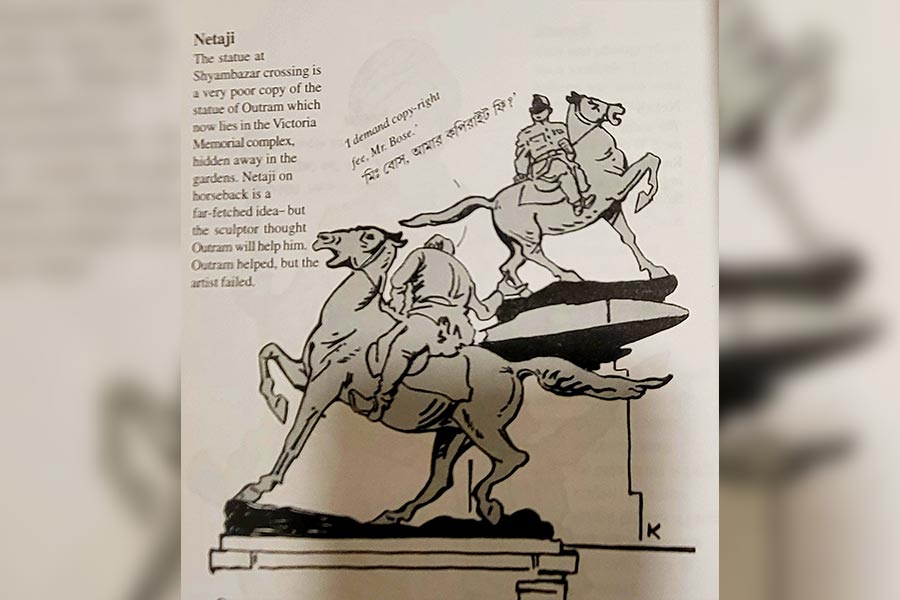
A cartoon of Netaji’s statue at Shyambazar by PKS Kutty
Netaji statue at Maidan
In December 1965, a huge full-figure statue of Netaji in INA uniform and pointing his index finger to the call of ‘Delhi Chalo’ got ready for public inauguration. On December 23, 1965, Prime Minister Lal Bahadur Shastri, his wife and Gulzari Lal Nanda arrived in Calcutta to unveil it. The 14-ft-tall bronze statue was sculpted by Prodosh Dasgupta and it was placed at the centre of a big roundabout at the Maidan, which made positive impact on the skyline of central Calcutta.
It was reported in newspapers that Prime Minister Shastri was overjoyed on seeing the great statue although many people complained that the face of Netaji was not good enough to reflect his burning personality.
Meanwhile, the Bengal government approved Rs 2 lakh loan to CMC for an equestrian statue of Netaji but the contract to make it was given to reputable Maharashtrian sculptor Nagesh Yoglekar (he is spelt as Yawalkar in some newspapers) with a 2-3-year deadline.
Inspiration from Lord Outram and Leonardo da Vinci
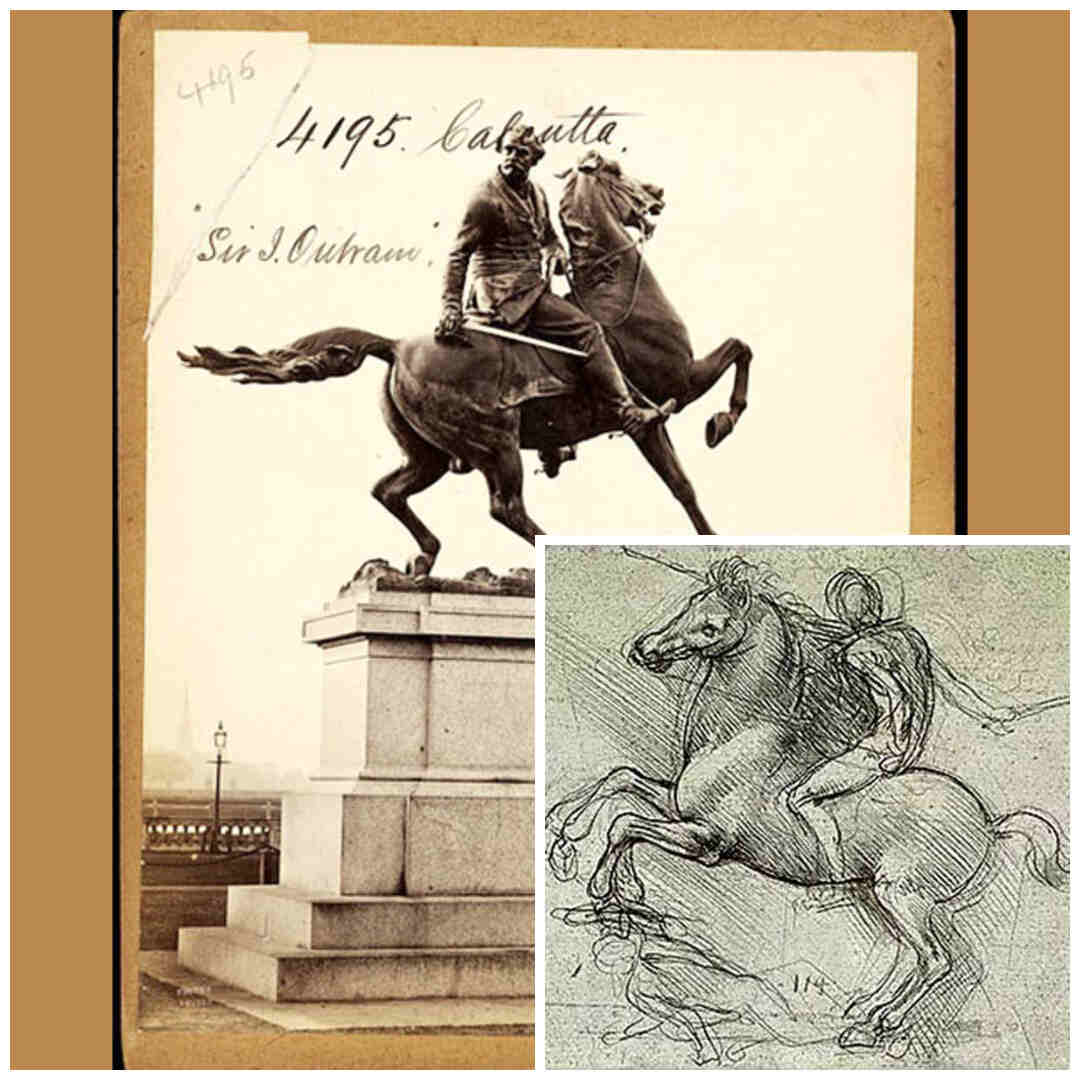
The statue of Lord Outram earlier placed at the Park Street-Chowringhee Road crossing and (inset) a copy of a rough sketch by Leonardo da Vinci done in 1482-copy
Yoglekar borrowed his idea of Netaji’s statue from that of Lord Outram established in 1861 at the crossing of Park Street and Chowringhee Road. Outram’s equestrian statue, sculpted by John Henry Foley, was heavily inspired by a sketch done by none other than Leonardo da Vinci in 1482 during the Sforza movement (a period in Renaissance Italy when the Sforza family ruled Milan from the mid-15th century till 1535).
From 1966 to 1968, the blame game over the abnormal delay in the project continued between the CMC and the West Bengal government.
Finally, 11 years after its formal announcement, the dream of Netaji admirers in north Calcutta became a reality.
D-day: January 23, 1969
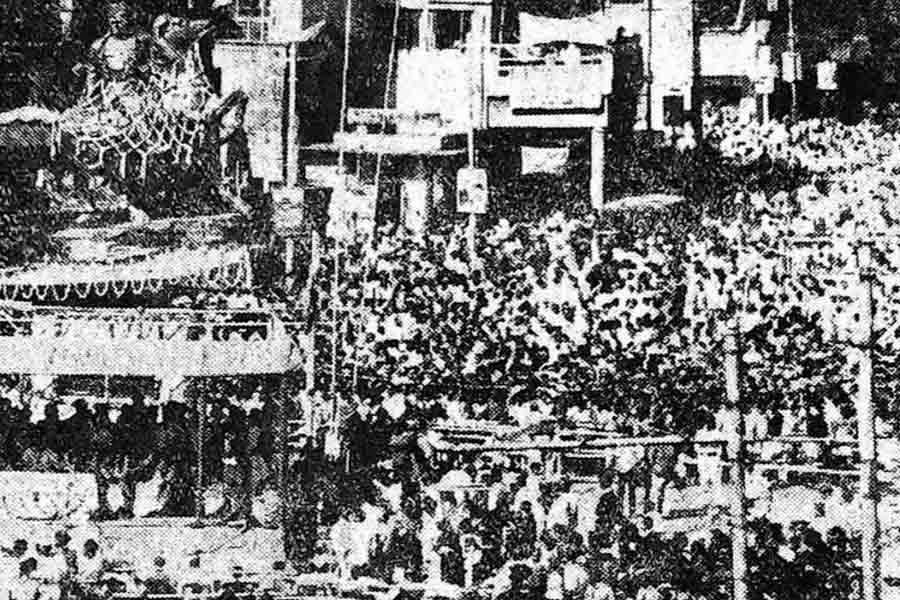
The photograph of the day of the opening of Netaji’s statue carried by ‘The Statesman’
Netaji’s massive bronze statue was set to be unveiled at the congested Shyambazar five-point crossing. Considering the massive gathering of common people, school students, local clubs and other organisations, traffic movement was stopped from all five directions towards Shyambazar. Traffic in entire north Calcutta had to be rearranged from January 22 evening itself.
Neither the Prime Minister nor the chief minister of West Bengal was selected to unveil the statue. Basanti Devi, the wife of Deshabandhu Chittaranjan Das, who was a mother-like figure to Netaji, was invited to unveil the 15.1-ft tall equestrian statue of Netaji placed on a 16-ft-tall pedestal. But at 92 years of age, Basanti Devi could not make it to Shyambazar but she sent her written blessings, which was read out to the public. Her recorded voice was also played on the loudspeakers.
Workers worked overnight on January 22 to complete the job, while police cordoned off almost all lanes and bylanes around Shyambazar to manage the crowds.
From 11am, Shyambazar was flooded with people, and at 12.15pm, the birth moment of Netaji arrived, Calcutta mayor Gobinda Chandra removed the golden curtain from the statue amid raising of Vande Mataram chants.
A majestic equestrian statue of Netaji emerged before the crowd. By following the European school of equestrian statues, one front hover of the horse was made half-folded and above the ground to signify the warrior went to battle and was wounded.
It was important to note that the sculptor did not design the horse with two front hovers in the air, signifying that the warrior went to battle and died. It shows the death of Netaji was still a great matter of doubt among common Indians, even in 1969. The statue showed Netaji slightly turned to his left, implying that he was seeing or talking to people.
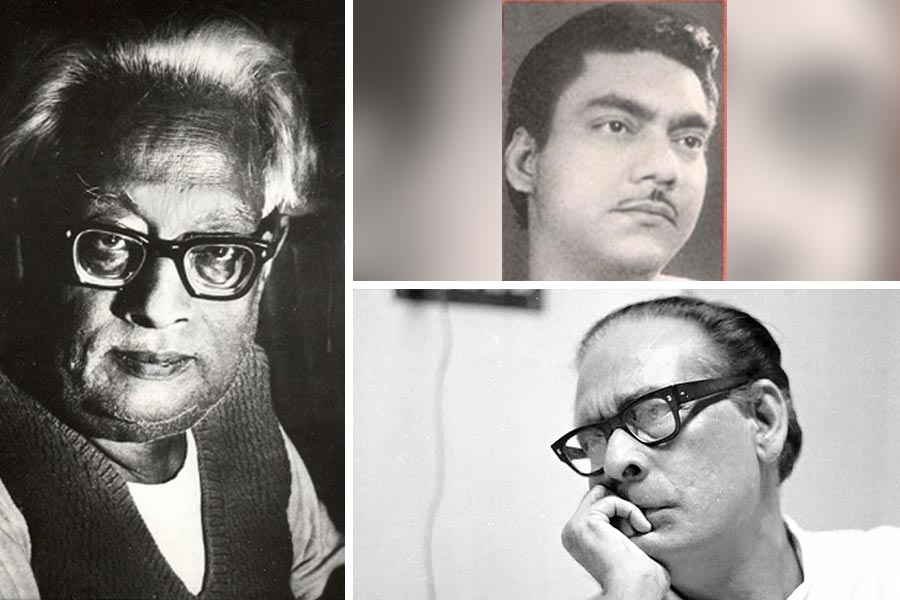
Chief guest at the function, scientist Satyendranath Bose; elocutionist-voice artiste Kazi Sabyasachi and singer Hemanta Mukherjee
The police band played Kadam, kadam badhaye jaa on their musical instruments and the sound of blowing of conch shells from all houses around Shyambazar rent the air. It was indeed a magical moment and Calcutta had never seen such enthusiasm around the opening of a statue. National professor and world famous scientist Satyendranath Bose graced the occasion as chief guest.
Thanks to the mad rush, Hemanta Mukherjee, who was invited to sing the inaugural song, could not reach the stage on time. However, he finally made it to the stage at the end of the function and mesmerised the crowd with the rendition of Tomar Ason Shunyo Aaji. Kazi Sabyasachi, reputable elocutionist, voice artiste and son of Kazi Nazrul Islam, recited his father’s famous song Durgama Giri Kantar Maru, which enthralled the attendees. Twice, Vande Mataram and Saare Jahan Se Accha were also sung.
Deputy mayor of Calcutta SK Khanna and former mayor Bijoy Banerjee were also present.
Of cheers & criticism
Nagesh Yoglekar, the sculptor of the statue, came from Bombay and he was cheered by the mob when introduced by the mayor.
The function continued till 1pm and thereafter, there was a rush to go near the statue. Many wanted to place garlands and flowers at the bottom of the statue. Some elderly even wanted to speak on Netaji.
However, Netaji’s statue and its location did not make everyone happy. At the end of the function, some people directly approached Nagesh Yoglekar and openly expressed their dissatisfaction. The Statesman on January 24, 1969, described “ ….One of them said that the horse looked too prominent : another man complained that the horse’s eyes lacked fire & lustre and its tail was oddly shaped”. Mr Nagesh tried to satisfy people and to his defence, blamed the wrong choice of location. The Statesman wrote next day that “…….he pointed out that Netaji’s posture with the horse’s fore leg up in the air was intended to convey he had drawn reins to speak to people around”.
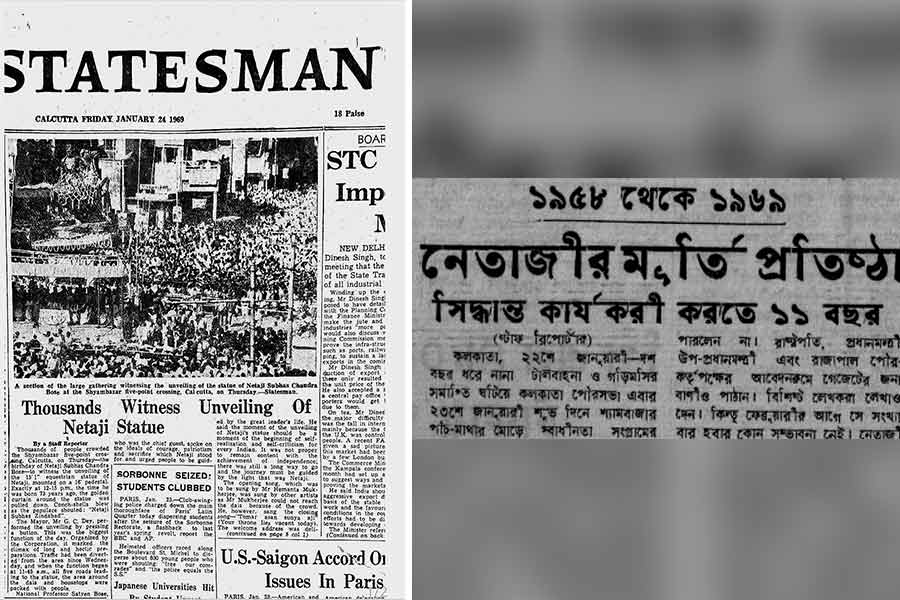
The reports that appeared in ‘The Statesman’ and ‘Jugantar’ over the Netaji statue opening in 1969
It is important to note that on the same day, another small-sized bronze statue of Netaji was unveiled at Presidency Jail.
The Shyambazar Netaji statue continues to be one of the biggest landmarks of Kolkata and is now more than a mere statue, but question still prevails about its merit.
Many are of the opinion that the sculptor was heavily influenced by the 1861 statue of Lord Outram by Foley, which was totally unnecessary considering Netaji’s stature.
The choice of place — the Shyambazar traffic island — and the size of the statue are a painful mismatch. The statue is too big for its pedestal and the locality is too congested to become a right background for such a grand statue. Yoglekar was more than correct when he clearly said that this statue was made for long-distance viewing and there is no scope at the Shyambazar crossing for such position. The space around the statue is so less than no one can enjoy its beauty while driving and lastly too much of noise and chaos around and lack of any green patch reduced the beauty of such a grand statue.
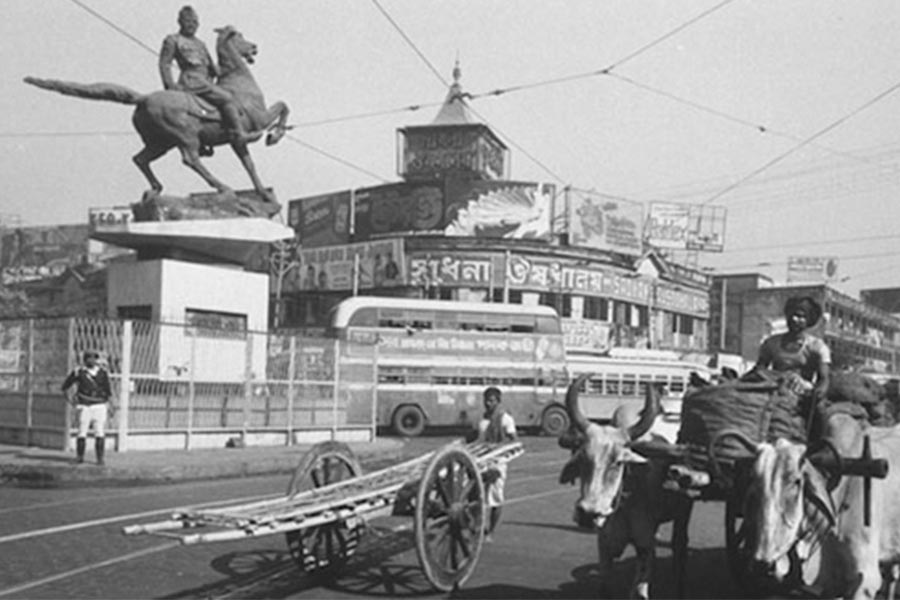
Shyambazar crossing in the 1970s
The biggest question came on placing Netaji on horseback. Does it really go with Netaji who as a warrior and took part in World War II as supreme leader of INA? Can anyone imagine fighting WW II on horseback? That actually could be linked to the 1928 Calcutta Congress, when a young Subhas rode a horse in military uniform to give guard of honour to Congress president Motilal Nehru at Park Circus Maidan.
That image of Bose gained immortality in hearts of millions and all present at Shyambazar on that day and many who still pass the statue even today still love to see their beloved leader as an equestrian warrior.
